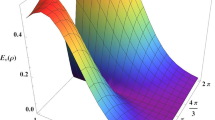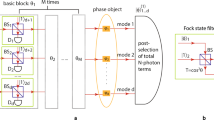Abstract
In two-mode interferometry, for a given total photon number N, entangled Fock state superpositions of the form \((|N-m\rangle _a|m\rangle _b+\mathrm{e}^{i (N-2m)\phi }|m\rangle _a|N-m\rangle _b)/\sqrt{2}\) have been considered for phase estimation. Indeed all such states are maximally mode-entangled and violate a Clauser–Horne–Shimony–Holt (CHSH) inequality. However, they differ in their optimal phase estimation capabilities as given by their quantum Fisher informations. The quantum Fisher information is the largest for the N00N state \((|N\rangle _a|0\rangle _b+\mathrm{e}^{i N\phi }|0\rangle _a|N\rangle _b)/\sqrt{2}\) and decreases for the other states with decreasing photon number difference between the two modes. We ask the question whether for any particular Clauser–Horne (CH) (or CHSH) inequality, the maximal values of the CH (or the CHSH) functional for the states of the above type follow the same trend as their quantum Fisher informations, while also violating the classical bound whenever the states are capable of sub-shot-noise phase estimation, so that the violation can be used to quantify sub-shot-noise sensitivity. We explore CH and CHSH inequalities in a homodyne setup. Our results show that the amount of violation in those nonlocality tests may not be used to quantify sub-shot-noise sensitivity of the above states.







Similar content being viewed by others
References
Pan, J.-W., Chen, Z.-B., Chao-Yang, L., Weinfurter, H., Zeilinger, A., Żukowski, M.: Multiphoton entanglement and interferometry. Rev. Mod. Phys. 84, 777–838 (2012)
Pezzé, L., Smerzi, A.: Mach–Zehnder interferometry at the Heisenberg limit with coherent and squeezed-vacuum light. Phys. Rev. Lett. 100(7), 073601 (2008)
Pezzé, L., Smerzi, A.: Entanglement, nonlinear dynamics, and the heisenberg limit. Phys. Rev. Lett. 102, 100401 (2009)
Plenio, M.B.: Logarithmic negativity: a full entanglement monotone that is not convex. Phys. Rev. Lett. 95, 090503 (2005)
Anisimov, P.M., Raterman, G.M., Chiruvelli, A., Plick, W.N., Huver, S.D., Lee, H., Dowling, J.P.: Quantum metrology with two-mode squeezed vacuum: parity detection beats the Heisenberg limit. Phys. Rev. Lett. 104, 103602 (2010)
Birrittella, R., Mimih, J., Gerry, C.C.: Multiphoton quantum interference at a beam splitter and the approach to Heisenberg-limited interferometry. Phys. Rev. A 86, 063828 (2012)
Dowling, J.P.: Quantum optical metrology—the lowdown on high-N00N states. Contemp. Phys. 49(2), 125–143 (2008)
Gerry, C.C., Knight, P.L.: Introductory Quantum Optics. Cambridge University Press, Cambridge (2005)
Holland, M.J., Burnett, K.: Interferometric detection of optical phase shifts at the Heisenberg limit. Phys. Rev. Lett. 71(9), 1355–1358 (1993)
Joo, J., Munro, W.J., Spiller, T.P.: Quantum metrology with entangled coherent states. Phys. Rev. Lett. 107, 083601 (2011)
Ono, T., Hofmann, H.F.: Effects of photon losses on phase estimation near the Heisenberg limit using coherent light and squeezed vacuum. Phys. Rev. A 81(3), 033819 (2010)
Seshadreesan, K.P., Anisimov, P.M., Lee, H., Dowling, J.P.: Parity detection achieves the heisenberg limit in interferometry with coherent mixed with squeezed vacuum light. New J. Phys. 13(8), 083026 (2011)
Uys, H., Meystre, P.: Quantum states for Heisenberg-limited interferometry. Phys. Rev. A 76, 013804 (2007)
Huver, S.D., Wildfeuer, C.F., Dowling, J.P.: Entangled fock states for robust quantum optical metrology, imaging, and sensing. Phys. Rev. A 78, 063828 (2008)
Hyllus, P., Gühne, O., Smerzi, A.: Not all pure entangled states are useful for sub-shot-noise interferometry. Phys. Rev. A 82, 012337 (2010)
Jiang, K., Brignac, C.J., Weng, Y., Kim, M.B., Lee, H., Dowling, J.P.: Strategies for choosing path-entangled number states for optimal robust quantum-optical metrology in the presence of loss. Phys. Rev. A 86, 013826 (2012)
Bhaskar, R.B., Jiang, K., Dowling, J.P.: Effectsof phase fluctuations on phase sensitivity and visibility of path-entangled photon fock states. Phys. Rev. A 88, 023857 (2013)
Giovannetti, V., Lloyd, S., Maccone, L.: Quantum metrology. Phys. Rev. Lett. 96, 010401 (2006)
Bell, J.S.: On the Einstein–Podolsky–Rosen paradox. Physics 1, 195 (1964)
Genovese, M.: Research on hidden variable theories: a review of recent progresses. Phys. Rep. 413, 319 (2005)
Gisin, N.: Bell’s inequality holds for all non-product states. Phys. Lett. A 154(5–6), 201–202 (1991)
Werner, R.F.: Quantum states with Einstein–Podolsky–Rosen correlations admitting a hidden-variable model. Phys. Rev. A 40, 4277–4281 (1989)
Yu, S., Chen, Q., Zhang, C., Lai, C.H., Oh, C.H.: All entangled pure states violate a single bell’s inequality. Phys. Rev. Lett. 109, 120402 (2012)
Gilchrist, A., Deuar, P., Reid, M.D.: Contradiction of quantum mechanics with local hidden variables for quadrature phase amplitude measurements. Phys. Rev. Lett. 80, 3169–3172 (1998)
Munro, W.J.: Optimal states for bell-inequality violations using quadrature-phase homodyne measurements. Phys. Rev. A 59, 4197–4201 (1999)
Clauser, J.F., Horne, M.A.: Experimental consequences of objective local theories. Phys. Rev. D 10, 526–535 (1974)
Clauser, J.F., Horne, M.A., Shimony, A., Holt, R.A.: Proposed experiment to test local hidden-variable theories. Phys. Rev. Lett. 23, 880–884 (1969)
Banaszek, K., Wódkiewicz, K.: Testing quantum nonlocality in phase space. Phys. Rev. Lett. 82, 2009–2013 (1999)
Wildfeuer, C.F., Lund, A.P., Dowling, J.P.: Strong violations of bell-type inequalities for path-entangled number states. Phys. Rev. A 76, 052101 (2007)
Gerry, C.C., Mimih, J., Benmoussa, A.: Maximally entangled coherent states and strong violations of bell-type inequalities. Phys. Rev. A 80, 022111 (2009)
Vidal, G., Werner, R.F.: Computable measure of entanglement. Phys. Rev. A 65, 032314 (2002)
Nielsen, M.A., Chuang, I.L.: Quantum Computation and Quantum Information. Cambridge University Press, Cambridge (2000)
Cirel’son, B.S.: Quantum generalizations of bell’s inequality. Lett. Math. Phys. 4(2), 93–100 (1980)
Gisin, N., Peres, A.: Maximal violation of bell’s inequality for arbitrarily large spin. Phys. Lett. A 162(1), 15–17 (1992)
Braunstein, S.L., Caves, C.M.: Statistical distance and the geometry of quantum states. Phys. Rev. Lett. 72(22), 3439–3443 (1994)
Braunstein, S.L., Caves, C.M., Milburn, G.J.: Generalized uncertainty relations: theory, examples, and Lorentz invariance. Ann. Phys. 247, 135 (1996)
Gerry, C.C., Mimih, J.: The parity operator in quantum optical metrology. Contemp. Phys. 51(6), 497–511 (2010)
Arfken, G., Weber, H.: Mathematical Methods for Physicists, Chap. 13, 3rd edn. Academic Press, London (1985)
de Oliveira, F.A.M., Kim, M.S., Knight, P.L., Buzek, V.: Properties of displaced number states. Phys. Rev. A 41, 2645–2652 (1990)
Wunsche, A.: Displaced fock states and their connection to quasiprobabilities. Quantum Opt. 3, 359–383 (1991)
Acknowledgments
J. P. D. and K. P. S. would like to acknowledge support from the Air Force Office of Scientific Research, the Army Research Office, the Defense Advanced Research Projects Agency, and the National Science Foundation. C. F. W. would like to add the following acknowledgment: I first met Howard at QCMC 2002 in Boston. He told me that as part of his formal education he went to the south of Germany and attended High School for a couple of years. He enjoyed chatting in German with me. Howard also introduced me to Jonathan P. Dowling at this conference who later hired me as a post doc. I met Howard several times at various international conferences over the past years. He always gave me advice on career moves and research topics, even in the weeks before his surgery. His encouragement and generosity made a deep impression on me, and I will never forget this extraordinary researcher and warm welcoming personality.
Author information
Authors and Affiliations
Corresponding author
Appendices
Appendix 1
Let \(\rho \) be the density operator corresponding to the \((N-m)::m\) state of Eq. (1), i.e.,
The logarithmic negativity \(\mathcal {\varepsilon }\) of the state can be calculated using the absolute sum of the negative eigenvalues \(\mathcal {N}=|\sum _{i}\lambda _i|\), \(\lambda _i < 0\) of the partial transpose of the density operator \(\rho ^{PT}\), as \(\mathcal {\varepsilon }=\log {(1+2\mathcal {N})}\). The partial transpose of \(\rho \) of Eq. (22) is given by
Diagonalizing the off-diagonal terms, \(\rho ^{PT}\) of Eq. (23) can be equivalently written as
where \(|\varphi _1\rangle \) and \(|\varphi _2\rangle \) are normalized two-mode states given by
The eigenvalues of \(\rho ^{PT}\) are \(\{1/2,\ 1/2,\ 1/2,\ -1/2\}\). We notice that they are independent of the values of N and m. Thus, the logarithmic negativity of all \((N-m)::m\) states is \(\log 2\).
Appendix 2
The correlation function \(\Pi (\alpha , \beta )\) of Eq. (16), for an \((N-m)::m\) state of Eq. (1), is given by
where we have used the fact that \(\hat{D}(\alpha )^{\dagger }=\hat{D}(-\alpha )\). Denoting displaced Fock states by \(\hat{D}(\alpha )|n\rangle =|\alpha ,n\rangle \), Eq. (26) can be rewritten as
Using the number basis expansion of states of the form \(|\alpha ,n\rangle \) as given in Ref. [39], one can show that
Therefore, Eq. (27) can be written as:
The inner product of displaced Fock states is given by [23, 40]
Using Eq. (30) in Eq. (29), the correlation function \(\Pi (\alpha , \beta )\) for the \((N-m)::m\) state is found to be of the form given in Eq. (17). Further, the two-mode Wigner function of the state can be written as
Rights and permissions
About this article
Cite this article
Seshadreesan, K.P., Wildfeuer, C.F., Kim, M.B. et al. On the connection between quantum nonlocality and phase sensitivity of two-mode entangled Fock state superpositions. Quantum Inf Process 15, 1025–1042 (2016). https://doi.org/10.1007/s11128-015-1082-1
Received:
Accepted:
Published:
Issue Date:
DOI: https://doi.org/10.1007/s11128-015-1082-1




